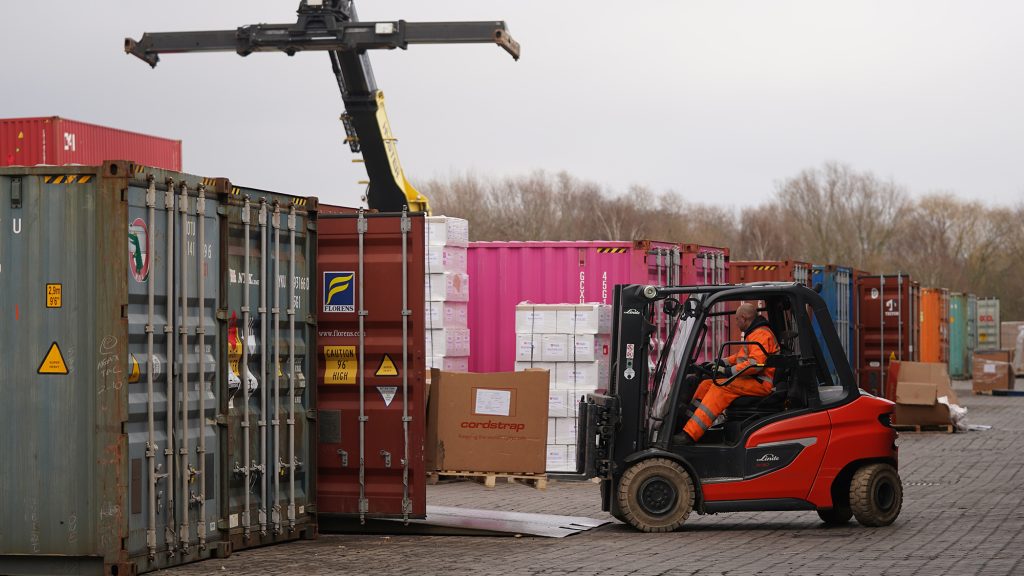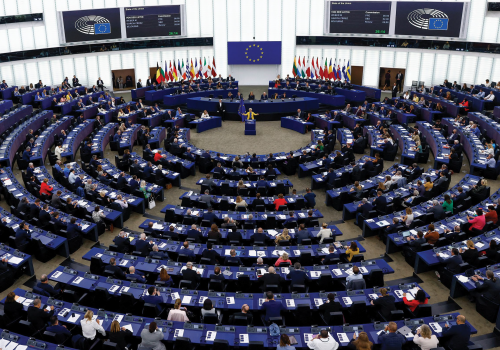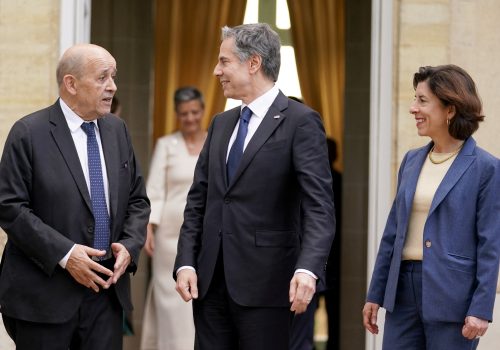SUMMARY
Trade and supply-chain issues will top the agenda at the third US-EU Trade and Technology Council (TTC) ministerial on December 5, but not for the right reasons. New transatlantic trade disagreements are taking center stage, possibly at the expense of previous ambitions for deeper cooperation and joint projects.
For example, although laudable for its measures on climate ambition, the US Inflation Reduction Act (IRA) has introduced local content requirements for electric cars and batteries that are viewed in Europe as an attempt to capture its manufacturing base, in stark contradiction with previous TTC commitments and World Trade Organization (WTO) rules against discriminatory trade policies. This dispute is the latest among several emerging challenges between the European Union (EU) and United States in building a common approach to secure supply chains—spanning everything from semiconductors to raw materials—and to forge common responses to China’s rise as a geostrategic rival. The TTC was set up to avoid and solve such disputes and deepen trade and tech collaboration. At the moment, it is not.
These issues will not be solved in the coming days leading up to the ministerial. But for the TTC to remain credible, US and EU leaders must show that they have the intention and capacity to overcome these hurdles. And for the December TTC meeting to be a success, the parties need to demonstrate progress toward implementing the objectives and commitments previously defined at the political level. Specifically, we present five tests for the parties to show progress on the trade and supply-chains agenda over the next six to twelve months.
The TTC must show that it can make the grand bargains and dynamic compromises necessary for a truly integrated trade and climate agenda across the Atlantic. This requires tackling demanding issues such as carbon accounting, subsidies, and the procurement of green technology. There is also a need to deepen the trade and commercial agenda by committing to tackling supply-chain challenges, assuaging trade irritants, and salvaging viable elements from previous attempts to deepen trade. And finally, stronger and transparent stakeholder engagement—at both the ministerial level and the working-group level—is needed to translate the political optimism around the TTC into true momentum and ensure long-term success.
Why trade and supply-chain cooperation top the agenda
In an attempt to break from Donald Trump-era disputes and irritants between the EU and the United States, the EU-US Trade and Technology Council launched in 2021 with the aim to deal jointly with a new paradigm of transatlantic trade in pursuit of economic security.
No two economic regions are as deeply integrated as the United States and Europe, a relationship based on interlinkages across investment, trade in goods and services, technology, innovation, and jobs. Crucially, sales by companies with affiliations on both sides of the Atlantic underscore this dynamic, with transatlantic foreign-affiliate sales estimated at a total of $5.7 trillion in 2020.
Even so, there is justification for longstanding concerns that the transatlantic trade and economic partnership is not living up to its potential in a fast-changing global economy. The ill-fated Transatlantic Trade and Investment Partnership (TTIP) experiment demonstrated the potential of deepening transatlantic trade, but its failure in 2016 also gave a warning: Trade is no longer perceived as a positive-sum game for transatlantic partners.
Now, with the COVID-19 pandemic and the war in Ukraine highlighting stresses and bottlenecks in international trade and supply chains, there are legitimate concerns over strategic rival China, which is subsidizing its domestic champions and leveraging asymmetric dependencies. China is now responsible for 20 percent of global trade in manufacturing of intermediate products used in supply chains, including several critical inputs and materials such as rare earths, for which both the United States and the EU are dependent on other countries—making them vulnerable to economic coercion.
Economic security and supply-chain resilience have thus moved to the top of the political agenda, with US politicians speaking liberally about “decoupling” from nonmarket economies and EU policymakers adopting a policy of “open strategic autonomy”—the latter even predating COVID-19 and the war in Ukraine, appearing in industrial policy initiatives to reduce supply-chain dependencies and accelerate the green transition.
In the private sector, supply and price shocks are forcing EU and US firms to reconsider their dependencies on international supply chains. There is already evidence that global supply chains are shortening, and McKinsey Global Institute has estimated that 15 to 25 percent of global goods trade could shift to different countries, becoming more regionally oriented, over the next five years as companies look to make their value chains more resilient.
The question remains whether the EU and the United States, through the TTC, can bring transatlantic coherence to domestically driven initiatives, avoiding competition and new irritants, in the name of deeper trade and mutual security. Since the Paris TTC ministerial in May 2022, which both sides remember for its positivity, it isn’t clear that much progress has been achieved.
No visible progress since Paris
Ahead of the third ministerial meeting, the TTC faces tough decisions as new irritants have complicated the US-EU relationship. On the IRA, US tax credits for electric cars made in North America and subsidies to the US battery industry have been condemned by the EU as breaches to the spirit of the TTC and WTO rules. While the United States likely will not adjust the package, the EU is willing to work toward a negotiated solution through a joint task force but will not rule out a complaint at the WTO.
The US has also enacted strict chip export controls against China even though the parties at the Paris ministerial had agreed to coordinate efforts to confront countries deploying nonmarket policies in order to avoid possible collateral consequences. US export controls do not yet have a European answer, despite significant pressure from Washington. This highlights how difficult coordination can be, but also that unilateral policies taken by one side bring about risks to the level playing-field and other knock-on effects, in this case for European businesses.
At the Paris ministerial, leaders set out an ambitious supply-chain agenda, particularly for semiconductors. Goals included a establishing a common early-warning and monitoring mechanism to better predict supply-chain disruptions, joint preparedness for supply disruptions, and information exchanges to avoid subsidy races. It still is not clear how information sharing will work in practice or whether both sides have developed the capacities needed for cooperation. Designing domestic measures in such a way as to reduce undesirable international spillovers in areas such as clean tech and semiconductors would be significant. But while there is commitment on paper to hold consultations, dialogue, and coordination—including on research and development (R&D) and investment—there is little evidence that concrete joint action is being taken, even on semiconductors, an issue for which overcoming shortages and gluts together should be an immediate priority.
In the EU, the European Chips Act is in interinstitutional discussions that will not be concluded until well into 2023. But in parallel, the European Commission is establishing an Observatory of Critical Technologies and has begun charting supply-chain dependencies and vulnerabilities with a primary focus on goods of low-level complexity; it is also due to put forward a Critical Raw Materials Act. In the United States, similar processes and ambitions have been set up across several areas of technology and raw materials with measures in the CHIPS and Science Act, which was signed into law in August. A challenge here might be that despite being hit harder, the EU has been slower in reacting to supply-chain emergencies. This raises questions of whether the United States is equally as dependent on the TTC’s success as Europe is, or if the United States might be just as content with unilateral action.
Finally, effective supply-chain policy is further hindered by EU and US reticence to talk about trade measures and market access. Reliability, quality, and diversity of sourcing are of primary importance when devising trade and industrial policy aimed at reducing dependence on geopolitical adversaries. At the same time, it is hard to ignore the cost dimension of rearranging supply chains amid high inflation, a concern that industry shares. The first step for the United States and Europe to ensure supply-chain resilience is therefore to remove impediments to trade with the most like-minded partners.
German Chancellor Olaf Scholz recently attempted to jumpstart action by suggesting some form of revival of TTIP talks—to great consternation both in Washington and Brussels. So far, the TTC’s ambitions for supply chains, standards, and technology is yet to spill over into more longstanding trade policy planning. It is a matter of debate whether the TTC or a revived TTIP would be the right framework for this, but it is clear that trade barriers—such as the tariff-rate quotas on steel and aluminum that still prevail—prevent long-term investment decisions in Europe and the United States and contribute indirectly to import dependence on China. Similarly, there are elements from the former TTIP agenda that would serve both economies well, such as increased cooperation on government procurement and conformity assessments.
Setting the agenda: Five tests for the Washington ministerial and beyond
As the third ministerial approaches, five tests are shaping up for officials and political leaders to show credibility in their ability to work toward the TTC’s ambitions over the next six to twelve months. These tests will show whether the TTC can develop a trade and climate agenda, within a grand bargain overall, by making compromises across several issues.
- Joint mapping and information sharing. Structures on both sides are becoming operational, with the EU’s Observatory of Critical Technologies a potential match for the US work on the Critical and Emerging Technologies List. But in the immediate term, the two parties must show they can deliver on their promise to jointly identify gaps and vulnerabilities across key resources, including those in the semiconductor value chain. This should include early-warning systems and cooperation on demand modeling. It is also time to look at how the trade and supply-chains agenda could advance a common climate agenda, for example, by proactively assessing gaps and identifying opportunities to incorporate the circular economy and the reuse of recoverable critical materials.
Beyond this, important questions remain as to whether sensitive emerging technologies—such as applied artificial intelligence, bio-machine interfaces, or quantum computing—should be included in the mapping and information-sharing process, and also whether the United States and the EU have the analytical capacities needed for proper technological foresight, as highlighted by the Brookings Institution’s Erica R.H. Fuchs. - From subsidy competition to operational synergies. The TTC needs to demonstrate that it can overcome an accelerating subsidy race not only for microchips, but also for green technologies such as those singled out in the IRA. The EU and United States must expeditiously find a solution that preserves legitimate interests on both sides. This effort, led by the recently announced EU-US Task Force on the Inflation Reduction Act, cannot be detached from the overall TTC process, and specifically Working Group 2 (Climate and Clean Tech). Discussions on climate and clean technologies must be brought to the fore of the political agenda with the aim of reaching a common understanding on the role of subsidies, local content requirements, and public procurement in enabling the green transition. The parties must also urgently develop common standards for carbon accounting, both to defuse potential tensions around the EU’s Carbon Border Adjustment Mechanism and as a path to agreement on steel and aluminum disputes.
In time, supply-chain cooperation could go much further and could involve common research, standards harmonization, and joint investments. Tobias Gehrke of the Egmont Institute recently proposed a joint EU-US industry consortium for hydrogen, batteries, and semiconductors, building on the EU’s budding industrial alliances while ensuring reciprocal participation on both sides of the Atlantic. Another way forward, suggested by Dan Hamilton and Joseph Quinlan in their AmCham EU report, would be to develop synergies between the US National Science Foundation and the Horizon Europe framework programs, for instance on research into nonsilicon microchips. - Overcoming irritants and settling disputes. There is a strong case for trying to settle IRA-type disputes without going to the WTO. This might involve tough bargaining and tit-for-tat. But it is crucial that the two parties, building on the frequent meetings of the working groups, adopt an “avoid and resolve” spirit with the intent to anticipate and defuse potential irritants, whether in relation to domestic actions, common challenges such as clean steel production, or autonomous trade measures covering public procurement, foreign subsidies, anti-coercion instruments, or export controls. Given the role they play in meeting today’s geoeconomic challenges, efforts must continue to make export-control policies and practices more transparent, efficient, and effective. In turn, as suggested by Guillaume van der Loo at the European Policy Centre, this can lay the groundwork for new agreements at the bilateral or multilateral level.
In the short term, the TTC’s soft approach will not result in binding or enforceable trade commitments, but it is worth exploring whether a future format stemming from the TTC, with a reliable system to settle disputes, could be achieved. - Embracing the missing agenda: deepening trade. Deepening transatlantic trade is an answer both to supply-chain concerns and the poor macroeconomic outlook. The EU and United States must therefore determine how to overcome their general reluctance toward anything that looks like a trade agenda. There is a clear case for raising ambitions for removing non-tariff barriers and reviving targeted aspects of the TTIP agenda. Diverging standards and double testing are important obstacles for many companies on both sides of the Atlantic. Cooperation on standard-setting, notably for new technologies, and a push for conformity-assessment agreements based on existing mandates like those on machinery stand out as possible quick wins for a revitalized TTC.
To get there, a first step could be to create a group of high-level experts with the mandate of finding what within the past trade agenda could be both economically rewarding and politically feasible on both sides. From this step, the two parties could explore the possibility of creating new trade packages, spanning current irritants, future challenges, and “classic” trade files, such as mutual recognition agreements and public procurement. - Enlarging the circle to likeminded countries. In key areas of geopolitical and economic competition, such as critical minerals and export controls, the TTC should aim to achieve a “club of friends.” Currently, it is mainly the United States driving the shift to “minilateral” formats (e.g. the Indo-Pacific Economic Framework, Chip 4, I2U2, the Quad, and the US-Japan Economic 2+2). By contrast, the EU, though fully engaged in the TTC, is still using its tried and tested method of free-trade-agreement negotiations to engage fast-growing economies that could provide alternatives to Chinese inputs. Differing approaches will lead to inefficiencies over time, so some transatlantic coordination is warranted. For supply chains, it should be clearer how initiatives led by the TTC relate to processes set up in the Group of Seven (G7) and other coalitions of the willing like the Minerals Security Partnership.
Further down the road, based on first successes, more ambitious multilateral projects could see the light of day. For instance, AmCham EU has called for a broader semiconductor consortium of like-minded nations, including Japan, Taiwan, and South Korea, that are able to develop a common innovation base with R&D of next-generation semiconductor designs and materials. The TTC may ultimately have to think beyond its countries’ borders to accomplish its biggest goals.
Charles Lichfield is deputy director of the Atlantic Council’s GeoEconomics Center.
Georg Riekeles is associate director and head of the Europe’s Political Economy program with the European Policy Centre.
This policy brief is the product of the Europe Center’s collaboration with the Brussels-based European Policy Centre on the “TTC Track 2 Dialogues” series, which aims to foster policy debate and stakeholder dialogue on the issues covered by the US-EU Trade and Technology Council.
Further reading
Tue, Nov 22, 2022
#AtlanticDebrief – What is the state of transatlantic trade & tech? | A Debrief from Tyson Barker and Ken Propp
Atlantic Debrief By
Europe Center Senior Director Jörn Fleck speaks with Tyson Barker and Kenneth Propp on the upcoming meeting of the US-EU Trade and Technology Council, European digital sovereignty, and more.
Wed, Nov 2, 2022
Digital sovereignty in practice: The EU’s push to shape the new global economy
Report By Frances Burwell, Kenneth Propp
What does the European Union's push for "digital sovereignty" mean in practice? Frances Burwell and Ken Propp provide an update to digital sovereignty and its transatlantic impacts.
Thu, May 19, 2022
Russian aggression brings EU and US together on trade and tech in France. What comes next?
New Atlanticist By
Our experts break down the US-EU Trade and Technology Council meeting and what it means for the future of transatlantic tech and trade policy.
Image: Containers are loaded on the premises of Saco Shipping GmbH, PCH Packing Center Hamburg. Photo by Marcus Brandt/DPA via Reuters.


